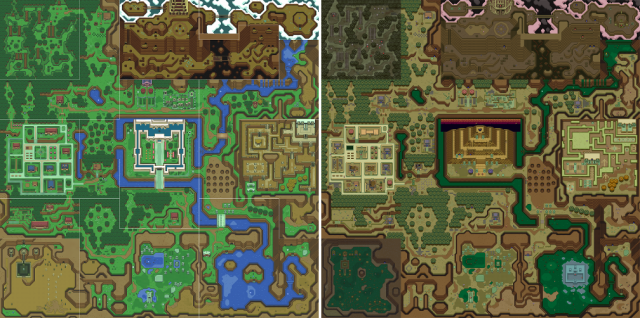Gossip Stone: Do Alternate Worlds/Time Periods Benefit Zelda?
Posted on September 06 2014 by Jon Lett

Zelda has repeatedly taken on the dual-map style, with a main world and a mirrored world that is usually accessable later on in the game. It was an idea introduced early on in the series, and has reoccured several times, even making its way into the two most recent Zeldas. The style has been used in many ways, including different worlds and time periods, but is it beneficial? Is it something that has been done well, and, more importantly, should it be done again? Take the jump to look back on how its been done, and to give us your thoughts!
This mirroring style started in the most obvious way, again, with A Link to the Past, where the layout of the Dark World was nearly identical to that of the Light World. Players had not seen this mechanic before, and I find it to be an incredible design tactic, doubling their game’s world, and more than doubling the amount of dungeons. This was done again years ater in A Link Between Worlds, where the two worlds were only slightly further from being identical, but this time, the game was meant to emphasize the differences for the story’s and gameplay’s sake, and it worked wonderfully.

Ocarina of Time did a similar thing, but instead of different worlds, the player switched between two time periods. This was also a revalation, as the change was not only a surprise, but the way things in the present effected the future, and the exploration of how things changed while Link was gone, made for a great new chapter of the game. Oracle of Ages also used this idea, but with a more direct time-travelling method, and with a much greater time difference. It was not quite as impressive, since it had been cclearly done before, as well as the characters between time periods not having such familiarity and relatablility, like in Ocarina of Time.
Then, there is the method of taking the same overworld, and tweaking it slightly to make things different for a certain period of a game. This has been done in Twilight Princess, Skyward Sword, and, in a fashion, Oracle of Seasons. Twilight Princess did it in the clearest way, covering the land in twilight, and using the overworld as a temporary dark realm for the evil beings currently running the place to run rampant, and it honestly worked rather well. The fact that it is the overworld that is usually quite full of people and new things to do just further pushes the player to beat the bad guys and save the place. Twilit Hyrule was different enough to have made it seem like a whole other world.
Skyward Sword simply used this as a method for trials in the form of Silent Realms. As much as I found the atmosphere of the Silent Realms cool, the length and purpose of them made them seem a bit unnecessary. One may think that some of these mirroring worlds are the developers’ way of having less work and not having to make brand new material, and I often disagree, but the way Skyward Sword did it is where I start feeling that way as well. At least Oracle of Seasons has consistent, on-the-fly changes of seasons for the sake of puzzle-solving, specifically later in the game when all four seasons were accessible. The Silent Realms, just seemed like… filler material.
The mirroring world/time period in a game should likely have major differences from it’s counterpart, like different dungeons and layout, rather than being stuck in for the sake of the occasional puzzle. In my eyes, it should be an essential part of the story or gameplay, or else players will probably treat it like just another way for the developers to push the game’s length over the 40-hour mark.
Now, it’s your turn. Should dark worlds make a return? Are differing time periods getting stale? Is it better for a game’s main world to stand alone as the game’s venue, or for Link to find a whole new world part-way through the journey? Let us know all you thoughts in the comments!



